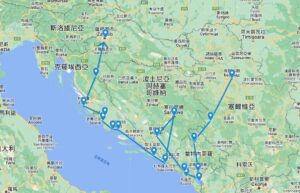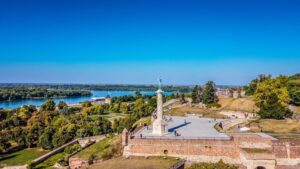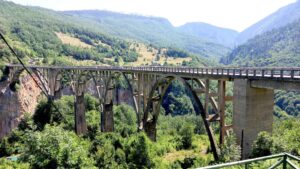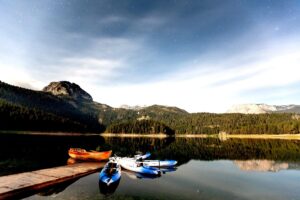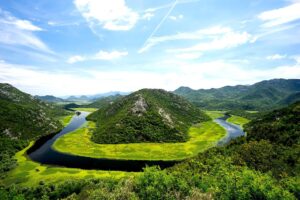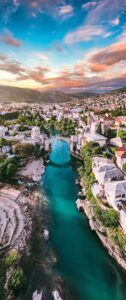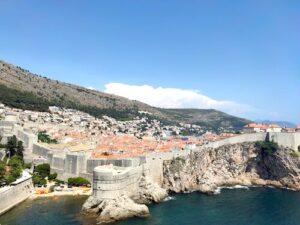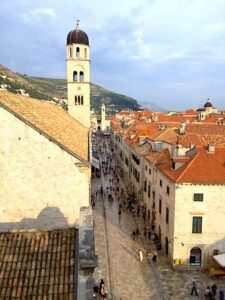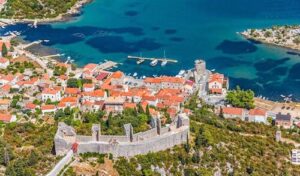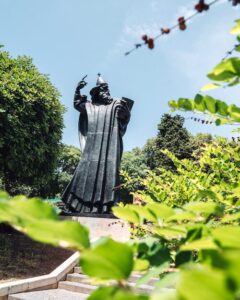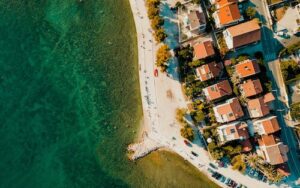We make special arrangements and alterations for private groups, contact us for details! Release date: October 19-November 5 Belgrade - Zlatibor-Zabuliak - Durmitor National Park - Podgorica - Lake Skadar - Budva - Kotor-Trebinj - Bragi - Mostar - Sarajevo - Dubrovnik-Stone - Split - Trogir - Sibenik - Krka National Park - Zadar-Plitvice Island - Zagreb ★Historical and Cultural Heritage: You will have the opportunity to visit the historical buildings and cultural heritage of Belgrade, as well as the Croatian cities of Dubrovnik, Split and Zagreb, which have a long history and unique culture. ★Natural Beauty: Along the way, you'll enjoy the spectacular natural beauty of Serbia and Croatia, including the mountains and waterfalls of Durmitor National Park, the scenic beauty of Lake Skadar, and the lakes and lush greenery of Krka National Park. ★Coastal City Tour: You will visit Sarajevo, Dubrovnik and Split in Croatia, which are located on the Adriatic coast with beautiful beaches and stunning coastal scenery. ★Cultural Diversity: This tour takes you to Serbia, Monte Negro and Croatia, which are rich in cultural diversity, where you can experience different regional customs, cuisines and traditional arts. ★National Parks Adventure: You'll have the opportunity to visit Durmitor National Park, Krka National Park and Plitvice Island, protected areas that offer rich ecosystems and breathtaking natural landscapes, allowing you to get in touch with nature at close quarters.
Daily Itinerary
* 19:30 Danube cruise sunset
- Belgrade Landmarks: Kalemegdan Fortress.
- Kalemegdan Fortress is one of the world's most complete surviving city fortresses, where the Danube and Sava rivers meet, and has been an important military center since the Celtic era, a place of war, where all the great empires took turns to put on a great show, and it is a must-visit site that combines humanities, history, and nature.
- Walk to the "Mihailo Street", which is a collection of beautiful buildings from the 19th century and is still bustling today.
- Visit St. Sava Cathedral, the largest Orthodox church in the world to date, which will be fully opened in 2022 after construction is completed. Entering the cathedral, you can truly feel the magnificence of the Orthodox church's mosaics and gold-leafed paintings, which will give you a breathtaking experience.
Points of reference:landmark military fortress, the confluence of the Danube and Sava rivers;
The largest Orthodox church in the world, with mosaic murals and gold leaf paintings.
Street art, local life and culture.
Sunset: Danube Castle Sunset
*Avala mountain
* Zlatibor King Lake
- Former chinese ambassade
- Today it is a Chinese cultural center, a must-visit place for every Chinese, a node in contemporary Chinese history, and a memory that must not be forgotten. A memory that must not be forgotten.
- Zemun Town
- Once an important town on the northern bank of the Danube during the Austro-Hungarian Empire, Zemun became part of Belgrade after World War I. The town is characterized by Baroque and modern architecture. The town's beautiful Baroque, Classical, Romantic, and Secessionist architecture makes you feel like you're walking into a completely different Central European city, and you'll be amazed.
- Tito's Memorial Museum
- Tito was a famous political leader of Yugoslavia. The Museum of Yugoslav History consists of the Flower House (Tito's Memorial Hall) and the Old Museum, which contains many precious gifts given to Tito by leaders of various countries and all sectors of Yugoslav society;
Inside the Flower House, in addition to Tito's tomb, there is also a permanent exhibition on Tito's life.
- Tito was a famous political leader of Yugoslavia. The Museum of Yugoslav History consists of the Flower House (Tito's Memorial Hall) and the Old Museum, which contains many precious gifts given to Tito by leaders of various countries and all sectors of Yugoslav society;
- Mount Avalanche: Belgrade's natural oxygen bar, a place to cleanse your lungs. The Monument to the Unknown Heroes and the Avalanche Tower are the city's landmarks.
- Monument to the Unknown Heroes: Designed in 1938 by the famous sculptor of the former Yugoslavia, Ivan Myshtlovic, eight statues of women with different images hold the top of the monument high, and these eight statues stand opposite each other, solemn and solemn, representing the eight main ethnic groups of the former SAARC. The Monument to the Unknown Heroes is an important venue for Serbian commemorative events, and has the appearance of a green hill and a cypress - a place where those who sacrificed their lives in the war of national defense are immortalized.
- Afterwards, proceed to Kanamatsu Ridge, visit the city center, take a stroll, dinner and check in at the hotel.
Points of reference:Feeding swans along the Danube River
View of the Baroque town from the Thousand Tourmaline Towers
Tito's Memorial, the memory of Yugoslavia and Tito's political powerhouse
Avalanche Mountain, with a view of the forests in autumn
Sunset at Jinzongling, a sacred place for vacation and recreation
* 6:00 climb mounain sunrise
- Zlatibor, also known as the Golden Pine, is a Serbian resort located in southwestern Serbia, named after the golden pines that cover the plateau at an altitude of 1,000 meters, with a mild climate that is conducive to good health. There is the longest cable car in the world, a 9-kilometer cable that connects the center of Zlatibor with the Tornik Mountains.
(Note: If the cable car service is suspended due to weather or other non-resistible reasons, we will transfer to other attractions or programs)
- The cable car is the longest in the world, connecting the center of Zlatibor with the Tolnik Mountains, a 25-minute one-way ride with breathtaking views of Zlatibor.Proceed to Serbia and pass by the Tara Bridge, which was used as a location for the famous former Yugoslavian movie "The Bridge", with its catchy theme song "Ah, Good-bye, Friend" still ringing in our ears. The bridge across Europe's deepest Tara River Canyon, is a reinforced concrete highway bridge, more than 300 meters long. The bridge was built between 1937 and 1940, and at the time of its completion was the largest highway concrete arch bridge in Europe. The bridge was actually destroyed by Yugoslav partisans in 1942. It was restored in 1946 and is still in use today.
- Located in Monte Negro, Zabuliak is a small town within the Dritta Valley National Park. The region is known for its spectacular alpine landscapes, glacial lakes and outdoor activities, including hiking, climbing and skiing. As one of the largest national parks in Monte Negro, the Derita Valley National Park protects a rich biodiversity that attracts visitors and nature lovers
Points of reference:
Sunrise over Zabljak
Ride the cable car to climb up and look down the valley
Tara Bridge Autumn View
Autumn view of Zabryak Mountain
/ / Lunch: Tara Local Meals Dinner: Local meal or hotel local buffet
- Durmitor National Park is the most beautiful national park in Montenegro. The scenery of this national park is magnificent, the limestone landscapes polished by ice and water are breathtaking, the Durmitor mountain range has 48 peaks of more than 2,000 meters, with the highest one, Bobotov Cuk, reaching 2,532 meters, and 18 glacial lakes scattered around the mountain called the eye of the mountain, and the largest one, the Black Lake, can be reached on foot from the entrance to the park 800 meters, which has a very pleasant view.
Tip: On the way to Podljigica, you will pass the famous Montenegrin Cliff Monastery "Ostrog", but because the monastery is built in the middle of the cliffs, the road leading to it is narrow and it is very difficult for the bus to reach it, so if you want to go there.If you want to go there, you have to park the bus at the bottom of the hill and walk up, which takes about 20 minutes.
This is for reference only.
This is for reference only.
- Afterwards, we will go to Podgorica, the capital of Montenegro, and visit The Cathedral of the Resurrection of Christ (inside), which is the largest church in Podgorica and the largest and most beautiful church in Montenegro, with a baroque dome style and a beautiful interior.
Points of reference:
View of the mountains and lake in Durmitor National Park
Cathedral of Christ Exterior Architecture and Interior
- Lake Skutai Located near Podgorica, Lake Skutai is the largest freshwater lake in the Balkan Peninsula and one of the largest national parks in Montenegro. It is famous for its flora and fauna diversity and is the largest bird habitat in Montenegro. There are 20 monasteries, churches, villages, fortresses and monuments in the area of Lake Skudar.
- St. Stefan's Island is a land-locked island connected to the mainland by a narrow, shallow beach about 100 meters long. The whole of St. Stefan's Island is a United Nations World Heritage Site. The island is now home to the Anchor Hotel, where you can stay, eat and visit. According to legend, when the father of the Turkish Navy, Barbarossa Hayrettin, attacked Kotor, the non-Hanseatic captains anchored their non-Hanseatic ships here, and only led the battleships into the Kotor Channel. However, the local pirates took advantage of the situation and completely looted the Turkish supply ships. From then on, the island became a base for pirates, who fought against enemies who wanted to conquer the island, including the Turks and Venetians. Gradually St. Stefan's evolved into a fishing village with a population of more than 400 people and 12 families living on the island around 1800. In the 1950's, the local government decided to turn the island into a resort hotel, so all the residents moved out, and it has since become an upmarket hotel, where Josep Broz Tito, Václav Havel, Britain's Princess Margaret, Sophia Loren, Carlo Ponti, Kirk Douglas, Stallone, Monica Vitti, Günter Grass, Alberto Moravia, Jane Birkin, Emil Custustodio and many others have stayed. Jane Parkin, Emile Kusturica, Claudia Cynford and hundreds of other celebrities have made St. Stephen's Island their vacation destination.
- Budva Old Town Located on a peninsula with a history dating back to the 15th century, the medieval walled Old Town of Budva, with its characteristic fortresses, towers and gates, can be described as a one-of-a-kind architecture and town, with narrow streets, small squares, cafes, boutiques, restaurants, galleries and more. Concerts, shows and exhibitions make the Old Town a "theater city" during the summer months. "Theater City" is also the name of a festival that has been held since 1987.
Points of reference:
Lake Skutai View
St. Stefan's Island
Budva Old Town
Sunset on the Adriatic Sea of Budva
*19:30 sunset
- The Old Town of Kotor, located at the end of the Kotor Gorge, is a small town surrounded by the Lovchen Mountains, the Vrmac National Park and the sea. Located below the steep San Giovanni hill, with its 16th century fortress on the top, the Old Town is one of the best preserved medieval settlements on the Mediterranean coast. The 5-kilometer-long, 20-meter-high, 10-meter-wide wall surrounding the Old Town is one of the most complete "Great Walls" in Europe. Museums, churches, a cathedral, palaces, stone streets, squares and intricately carved steps and gates lead you into a fairytale world. It is a UNESCO World Heritage Site.
- Kotor Castle: The fortress at the top of the Kotor Walls, known as the Fortress of San Giovanni, is the best place to see a panoramic view of the Bay of Kotor.
- The Walls of Kotor, located in the eastern part of the Old Town, are about 4.5 kilometers long. The wall is built on an almost vertical cliff and is much harder to climb than the Great Wall of Badaling.
- St. Tryphon's Cathedral: This is the most famous historical site in the Old Town of Kotor. The cathedral was built in the 12th century on the site of a 9th century church dedicated to St. Tryphon, the patron saint of Kotor. It is the oldest surviving cathedral on the east coast of the Adriatic Sea.
- Special Gift: [Perast Holymother island by boat Our Lady of the Rocks】To Perast to take a boat trip to Holymother Island, visit the Church of Our Lady of the Rocks (exterior) and the Museum (exterior).
(Note: If the ferry service is suspended due to weather conditions, this free program will be automatically canceled. will be canceled automatically)
Warm tips: If you have enough time, you can arrange a yacht trip at your own expense.
Points of reference:
Kotor Historical Site and Local Folklore
Pelast Old Town
Our Lady of the Rocks
Sunset on the Adriatic Sea
* 20:00 Old Bridge Lighting
- Trebinje is the most important red wine producer in Bosnia and Herzegovina. Trebinje is also famous for its mysterious churches and monasteries. One of the most important Orthodox monasteries, the Tverdos Monastery, was built on the right bank of the Trebizjac River, about 5 kilometers away from Trebinje, and its magnificent frescoes from the 16th century as well as the old wine cellar are the most worthwhile parts of the monastery.
- Blagaj Spring and Mosque
The Buna Spring is a rocky spring, the largest karstic rocky spring in Europe, with very clear water, which is the source of the Buna River, and the historical building called "Blagaj Tekke" on the edge of the cave was built in the 16th century. Blagaj is the name of the place and "tekija" is the Sufi lodge or guest house of the Islamic mystics. This is a collection of rocky springs and historical buildings, which are the historical and natural heritage of BiH.
Crooked Bridge is a 2-minute walk west from the Old Bridge over the Neretva River.
Points of reference:
Trebinje hilltop church with a panoramic view of the old town
13th Century Old Monastery and Vineyards Braga
Sunset and night view of Mostar
* 19:30 Yellow Castle sunset
- Mostar Bridge is a 16th century bridge over the Neretva River in Mostar, Bosnia and Herzegovina.
- The bridge stood for 427 years and was destroyed on November 9, 1993 during the Bosnian War. A reconstruction project was started and the bridge was reopened in 2004.
- The Mostar Bridge is arched, 4 meters wide and 29 meters long. There is a stone bridgehead at each end of the bridge.
- The arches are made of local stone. The current shape of the arch is due to a large number of irregular deformations of the inner curved surface of the arch.
- The piers of the bridge are of limestone and are connected to the wing walls of the waterside cliffs. Prior to the war, diving on the bridge was an annual sport for young men who competed with each other to win the favor of the girls from the same town.
- In 2004, to celebrate the reopening of the bridge, nine boys jumped off the bridge together.
- The Old Town of Mostar, a deep valley across the Neretva River, was first recorded in 1442. Inside the city, there are many Turkish-style buildings and old bridges, slate-arched bridges, prisons, umbrella factories, restaurants and other monuments. Whether you look to the east or west, the valley is still beautiful and spectacular, the river is clear and green, and the old city is simple and unadorned, with more than 600 soldiers buried in the Martyrs' Mausoleum in the distance who sacrificed their lives for the independence of the motherland.
- Ghazi Husrev Beyg Mosque: Located in the center of Sarajevo's Old Town, the mosque was built in 1531 under the auspices of Gazi Husrev Bey, who was the Ottoman governor of Bosnia at the time. Completed in 1531, the mosque was rebuilt in the 1990's due to damage sustained during the civil war, and it is now the largest and most important historical building in the whole of Bosnia-Herzegovina as well as a center of Islamic religion. There is a mausoleum in the center of the temple, where many great figures in the history of Bosnia and Herzegovina have been laid to rest.
- Old City Hall The triangular-shaped building has a mixture of Islamic and Austro-Hungarian styles. It was built during the Austro-Hungarian rule and was transformed into the National Library during World War I. During the Bosnia-Herzegovina War, the building was used as the National Library. During the war in Bosnia and Herzegovina, on the night of August 25, 1992, the City Hall was set on fire by Serbs, destroying more than 90% of the library collection. With the assistance of the European Union, the reconstruction of the library began in 1996, and on May 9, 2014, the library was reopened.
- Sarajevo Clock Tower The classic scene from the movie "Valter Defends Sarajevo" is reproduced.
- Latin Bridge On June 28, 1914, Archduke Ferdinand, the Crown Prince of Austria-Hungary, was killed on this bridge. This was also the trigger for the First World War. Başçarşırcıa] The Old Town is a maze of tiny streets and alleys that are bustling with activity, so wander through the small stores and see how craftsmen turn ordinary sheet metal into glittering wares. The cobblestones on the road have been worn smooth by pedestrians, and behind all the glitz and glamor is the soul of Sarajevo.
- The Yellow Fortress, an artillery fortress at the entrance, was built between 1727-39 and was one of the defense points against the Austro-Hungarian army in 1878. Currently used as a viewing platform, it is the best place to see the city, with a great view of Sarajevo and the large white cemetery below, a spectacular sight. The hill above is also a scene more familiar to the Chinese: in the movie "Walter defends Sarajevo", the German officer says at the end of the scene on the hill: "Sehen Sie diese Stadt? Das ist Walter " (Look at this city, this is Walter).
Points of reference:
Mostar Old Town
Battle of Neretva Broken Bridge Site
Sarajevo Old Town
Yellow Castle Sunset
- Dubrovnik is a port city in southeastern Croatia, a world-renowned tourist destination across the sea from Italy.
- Red-roofed cottages, blue sky and white clouds. The picturesque scenery can really make you stay in the city.
- As the city walls of Dubrovnik remain intact, it is the best time to climb the Dubrovnik City Walls in the evening, which surround the old city. Standing on the walls, you can overlook the white stone architectural jewels in the old city, and enjoy the charming view of the Adriatic Sea.
- You can climb the Dubrovnik City Walls at sunset (it takes about 1.5 hours to walk around).
Points of reference:
Sunset on the Dubrovnik Walls
Dubrovnik Old City Walls Sunset (it takes about 1.5 hours to walk around) It is recommended to go there in the evening to shoot the sunset.
- Dubrovnik Dubrovnik is a port city in southeastern Croatia, a world-famous tourist destination across the sea from Italy.
- Red-roofed cottages, blue sky and white clouds. The picturesque beauty of the city can really make you leave your heart behind.
- As the city walls of Dubrovnik remain intact, the evening is the best time to climb up the "Old City Wall", which surrounds the old city. Standing on the wall, you can not only overlook the white stone architectural jewels in the old city, but also enjoy the fascinating view of the Adriatic Sea.
- The old town boasts attractions that are always crowded with tourists, such as the Great Onofrio's Fountain, features the Baroque loggia and the world's third oldest pharmacy in the Franciscan Church and Monastery, the Sponza Palace that survived the great earthquake, the quirky Orlando's Column, and the city's vantage point, the Bell Tower. Scattered throughout the old town are countless churches, squares, museums, and residences of famous figures, which reflect the weight of history and the convergence of cultures. Every street corner, every building, and every courtyard is worth careful exploration.
- St. Blaise's Church is a magnificent Baroque church, an important church built in honor of the Guardians of Dubrovnik. The church has a dignified and striking appearance, with a statue of St. Blaise on the roof. The church is easily accessible and is located on Stratton Avenue. Many summer festivals and the town's New Year's Eve celebrations are held in the front of the church. The interior of the church is adorned with vaulted ceilings, a marble altar, and a silver-plated statue of St. Blaise guarded by two angels.
- Avenue Stradun, also known as Placa, is the main street of Dubrovnik and has been the center of the city's activity since the 13th century. In fact, it was once a waterway, which was later filled in and a new road built. In 1667, a massive earthquake almost destroyed the buildings lining the street, which eventually had to be rebuilt. The white limestone streets run east-west, dividing the Old Town of Dubrovnik into two roughly equal parts, and are lined with restaurants, bars and cafes.
- The Cathedral of the Assumption of the Virgin Mary , also known as the Church of the Assumption of the Blessed Virgin Mary, is the current site of the Cathedral of the Diocese of Dubrovnik. The Baroque cathedral was built in 1713, but a church has existed on the site since the 6th century. It is located to the right of the Governor's Palace on Stradun Avenue. The interior of the Cathedral is famous for its stunning violet-colored marble altar and its fine paintings by Dalmatian and Italian artists. The highlight is the church's treasury, which houses many famous artifacts, such as the gilded body parts of St. Blaise, as well as other artifacts from around the world. The Cathedral of Dubrovnik welcomes visitors free of charge every day, but there is an additional fee of 15 HRK to visit the gallery.
- Tip: If you have enough time, you can arrange an optional boat trip to the sea!
Points of reference:
Dubrovnik Old Town and Churches
Sunset in Dubrovnik
- Ston is a town famous for the Ston Wall. "The Ston Wall was an ancient series of stone walls used for military defense, initially 7 kilometers long, encircling the town of Ston, which was once part of the Ancient Republic of Saxony and is now located in the southern part of Croatia. The Ston Defense Wall is known as the "Great Wall of China in Europe".
Points of reference:
Private tour of the Great Wall
Split Sunset
- Split, the historical city of Croatia, is also known as a place of healing and sightseeing. Split is famous for the palace of the Roman Emperor Diocletian, which was built here after his abdication.
- The Diocletian's Palace was built only 6 kilometers away from Salona, and its magnificence is unique among the buildings of its time.
- Its grandeur and magnificence is unique among the buildings of its time, and naturally it has been the heart of Split since ancient times, and is a world cultural heritage that has been preserved to this day and is a source of pride for countless Split people.
- The Church of St. Dominus was the mausoleum of Diocletian the Great, which later became the Church of Christ, and in the Middle Ages a 57-meter-high bell tower was added, making it a very unique building.
- Bishop Gregory's statue is another symbol of Split, and it is said that touching the statue's toes will bring good luck.
- Stroll through the old town of Trogir, a small town near Split, with its unique castle and buildings, full of vitality and tranquility, strolling through the alleys is like entering a paradise.
- The ancient city of Trogir is a stunning cultural heritage site found on the Gulf of Dalmatia and is the most visited old town in Croatia.
- Built on Greek and Roman ruins, the ancient city is a remarkable example of a medieval city that retains the architectural influences of both.
- Moreover, Trogir has preserved its urban architecture so well that it has hardly allowed the influence of modern culture, and every view of the city is a remarkable testimony to the history of social and cultural development.
- Walking into the old city is like stepping into a movie, everything around you is a trance, as if you have traveled through time and space.
Points of reference:
Old Town of Split
Old Town of Trogir
Sibenik Coast
* 19:30 Sunset over the sea in Zadar
- Sibenik, the most beautiful ancient town in Croatia, was built in the 10th century A.D. The city is dominated by St. James' Cathedral, which has been inscribed on the UNESCO World Heritage List, and has preserved its medieval, famous Gothic architecture.
- Overnight stay at the Adriatic Marina Hotel. The small city is built along the coast. Walking along the promenade, you will see the blue Adriatic Sea on one side and the city built on a high slope on the other.
- On the north side of the square in the center of the old town, the simple stone houses are built on the hill, and the highest point is the San Michele Fortress; on the south side is the famous St. James Cathedral.
- As an architectural gem of the Dalmatian Coast and a world heritage site, it is the masterpiece of the famous architect Eula Damatia. It is the masterpiece of the famous architect Eula Damatia. Built between 1431 and 1535, it is the largest stone church in the world not supported by bricks or wood.
- Korca National Park is known as "the national park with the most beautiful waterfalls in Europe", second only to the Plitvice Lakes National Park in terms of scenery and popularity.
- The water cascades down the calcified dam steps to form a spectacular waterfall.
- As one walks through the park, sometimes the paths wind through the forest, and the walkways are intertwined with the dense forests and streams; sometimes the walkways are self-supported by lakes, and the sky opens up before one's eyes; and sometimes the jungle is so dense that it is like a treasure hunt in a dense forest.
- Like many landscapes in Croatia, this national park is also one of the most important locations for the American drama "Game of Thrones", where Ilya and the hound "Hound" used to walk between rivers.
Points of reference:
Colca National Park
Sunset over Zadar Sea
- Zadar is a port and historic city in western Croatia. The city has many medieval churches and Romanesque architectural monuments and is one of the most famous tourist destinations in Southeast Europe.
- It is a small city, and the main sights can be explored on foot. St. Donat's Church, a pre-Romanesque church with a rounded façade.
- St. Anastasia's Church and Bell Tower is the largest church in Dalmatia. The oldest part of the church is an early Christian church with its current Romanesque façade formed in the 12th century.
- Next to the harbor is the famous Land Gate, one of the most elaborate gates in Zadar with the most beautiful carvings. Come to the Sea Organ and pay homage to the sun, a unique sight in Zadar.
/ / Lunch: Optional Dinner: Local meal or local buffet at the hotel
- Transfer to visit the Prittville Lake National Park.
- Lake Plitvice Lakes is composed of 16 interconnected natural lakes, so it is commonly known as the Sixteen Lakes.
- The total area is 2000 hectares and 10 kilometers long. The height difference between the lakes is as great as 135 meters between the first lake and the sixteenth lake. Between the lakes, hundreds of large and small waterfalls like silver coils are formed, with the biggest waterfall dropping 76 meters into a trapezoidal shape and flowing down in sections.
- Sparkling blue waves in the lake, the lake on both sides of the broken wall cliffs, lush forests, beech trees, cedar trees and Kubu elm lush, like a picture of mountain springs flowing green.
- With its unique natural beauty and scientific value, Pritvice Lakes were inscribed on the World Heritage List by the World Commission on Natural and Cultural Heritage of the United Nations Educational, Scientific and Cultural Organization (UNESCO) in 1980.
Points of reference:
Sixteen Lakes Park Panorama Shooting
- Take the shortest tram ride from the Upper Town to the Lower Town.
- Zagreb Old Town Tour + Photography, Governor Jeláčić Square is the central square of Zagreb with the statue of Jeláčić, the first governor of Croatia.
- Most of the buildings around the square are from the 19th century and show a variety of architectural styles, from Biedermeier to Art Nouveau and Post-Modernism.
- St. Mark's Church, located in the center of St. Mark's Square, was built in the 13th century.
- On the top of the church, the emblem of Croatia-Dalmatia-Slavonia is embedded on the left side, and on the right side is the coat of arms of the city of Zagreb.
- The interior of the church is beautifully carved with different images. On the east side of St. Mark's Square is the Croatian Parliament and on the west side is the Croatian Prime Minister's Office.
- Zagreb Cathedral The church was built in the 11th century. In 1094, King Radislav I of Hungary proclaimed the establishment of the Catholic Diocese of Zagreb and built the church.
- In the 13th century, the church was destroyed by Tatars. After several restorations and the construction of two new Gothic towers (104 and 105 meters high) at the beginning of the 20th century, the church regained its former splendor. The church has become one of the symbols of Zagreb.
- Clock Tower of Lotrščak was built in the 13th century as a defense against foreign invasions.
- In the past, the bells of the clock tower rang every night when the city gates were closed, signaling the people outside the city to return to the city.
- At the end of the 19th century, the Zagreb Municipality decided to purchase a cannon that would be rung every day at noon to standardize the ringing of the bells of the churches in the city.
- The clock tower, now a museum, offers a spectacular view of the city from its top.
- Trg bana Josipa Jelačića The square was built in the 17th century. The square was first called "Mandushevac".
- Historically, as Zagreb grew, the Old Town could not cope with the increasing commercial activity.
- In 1641, the city council decided to move the commercial center to the new town and open a new marketplace by the "Mandushevac" spring, which gradually developed into the new city center.
- In 1848, the square was given its present name. After the end of World War II, the square was renamed "Republican Square" during the former Yugoslavia.
- In 1991, after the independence of Croatia, the square again resumed its old name.
Points of reference:
Old Town Zagreb
1:35pm Flight Arrive 3 hours prior to the airport







